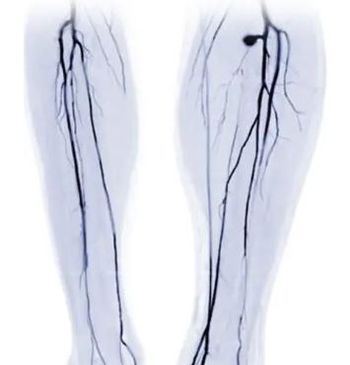
Ischemic Stroke: Update on Prevention Part 1, Surgery, Stenting, or Medical Therapy?
Selecting the most effective stroke prevention strategy for patients with cerebrovascular disease can be challenging.
Selecting the most effective stroke prevention strategy for patients with cerebrovascular disease can be challenging. There is a wealth of evidence-yet, at the same time, a number of "gray areas" remain. In addition, the numerous comorbidities that are often found in patients with carotid occlusive disease complicate risk stratification.
In this article, we address questions that primary care clinicians frequently ask about the relative merits of carotid endarterectomy (CEA), carotid angioplasty and stenting (CAS), and medical management in various patient populations. We review the best available data and then provide a summary of recommended, evidence-based management strategies. On page 615, we address questions about the role of statins and various antiplatelet regimens in stroke prevention.
What is the appropriate treatment of symptomatic carotid disease?
CEA versus medical management. The North American Symptomatic Carotid Endarterectomy Trial (NASCET),1 European Carotid Surgery Trial (ECST),2 and Veterans Affairs (VA) Cooperative Studies Program3 are the pivotal trials of the effectiveness of CEA for the treatment of symptomatic carotid occlusive disease. In NASCET, the 2-year ipsilateral stroke risk in patients with symptomatic stenosis of 70% to 99% was 26% in the medical arm (n = 331) and 9% in the surgical arm (n = 328) (P < .001). The number needed to treat (NNT) to prevent 1 stroke was 6 (NNT = 12 at 1 year). In ECST, the 3-year risk of major stroke or death in patients with symptomatic stenosis of more than 60% was 26.5% in the medical arm (n = 220) and 14.9% in the surgical arm (n = 356) (P < .001). The NNT to prevent 1 stroke annually was 21. Among men enrolled in the VA cooperative study, the results for those with greater than 70% stenosis were comparable, with an estimated stroke risk of 25.6% in the medical arm and 7.9% in the surgical arm. However, this last study was terminated early after NASCET and ECST published preliminary results that demonstrated the superiority of surgery.
Symptomatic patients with moderate degrees of carotid stenosis (50% to 69%) were also studied in NASCET.4 The benefit of surgery for moderate carotid stenosis was less robust than the benefit achieved in patients with high-grade stenosis and was dependent on patient factors. The 5-year ipsilateral stroke risk was 22.2% in the medical arm and 15.7% in the surgical arm (P = .045). The absolute risk reduction (ARR) with CEA was 6.5% (1.3% per year), and the NNT to prevent 1 stroke was 15 (NNT = 77 at 1 year). Patients 75 years or older, men, patients with stroke (rather than transient ischemic attacks [TIAs]), and patients with hemispheric (rather than retinal) symptoms received the greatest benefit.
Both NASCET and ECST demonstrated the superiority of medical management over surgery for patients with symptomatic stenosis of less than 50%. Note that patients with complete carotid occlusion were not included in NASCET and ECST; surgery is not indicated in this population.
Assessing degree of stenosis. Accurate measurement of the degree of stenosis is critical to identifying those patients who are most likely to benefit from surgery. Intra-arterial angiography (IAA) (Figure) was used to assess carotid stenosis in the pivotal clinical trials that demonstrated the efficacy of CEA for symptomatic disease. The advent of noninvasive vascular imaging modalities, such as carotid duplex ultrasonography and MR angiography, has reduced reliance on IAA. However, because of technical limitations of these noninvasive modalities, they may misclassify the degree of stenosis in 10% to 15% of patients.5
In general, if the results of 2 noninvasive tests are concordant, IAA is not warranted. If, however, the results of noninvasive imaging tests are not in agreement, IAA may be indicated.
Timing of CEA. The optimal timing of surgery has yet to be definitively established; however, the risk of early recurrence after TIA has prompted recommendations to perform CEA without delay-preferably within 2 weeks of symptom onset-in neurologically stable patients.6,7 For patients who have sustained a stroke of moderate or large size, surgery may be deferred several weeks to minimize the risk of reperfusion injury.
Perioperative medical therapy. Low-dose aspirin (81 or 325 mg daily) administered before surgery has proved superior to high-dose aspirin (650 or 1300 mg daily).8
CEA versus CAS in high-risk patients. The following medical comorbidities and anatomical features may increase the risk of surgery-related complications:
- Age 80 years or older.
- Severe congestive heart failure.
- Severe coronary artery disease.
- Recent myocardial infarction (MI).
- Severe chronic lung disease.
- Severe renal disease.
- Contralateral carotid occlusion.
- Previous radical neck surgery or radiation therapy.
- Previous ipsilateral CEA.
- High carotid bifurcations.
Patients with these conditions were underrepresented or not included in the early surgical trials; therefore, the results of NASCET and ECST are not easily extrapolated to such patients. Less invasive approaches to revascularization, such as CAS, may reduce the risk of procedural complications in these patients.
To date, the only randomized trial of CAS and CEA in high-risk surgical patients is the Stenting and Angioplasty With Protection in Patients at High Risk for Endarterectomy (SAPPHIRE) trial.9 In a non-inferiority study design, 334 patients with either symptomatic carotid stenosis of 50% or greater or asymptomatic stenosis of 80% or greater and at least 1 high-risk surgical condition were randomly assigned to either CEA or CAS with use of a distal protection device.
The 30-day risk of stroke, death, or MI was 4.8% for CAS and 9.8% for CEA (P = .09). The primary end point of stroke, death, or MI at 30 days plus death or ipsilateral stroke at 1 year was 12.2% for CAS and 20.1% for CEA (P = .004). MI was more frequent in the surgical group (2.4% vs 6.1%) and greatly affected the observed differences between CEA and CAS. Moreover, there was no statistically significant difference between the 2 groups in the prespecified long-term outcome (a composite of death, stroke, or MI within 30 days of the procedure or ipsilateral stroke between 31 days and 3 years postprocedure).10
A review of more than 2500 CEA procedures performed in octogenarians found a combined perioperative stroke and mortality rate of 3.45%.11 Thus, in the absence of other high-risk conditions, CEA should not be withheld from patients older than 80 years if their life expectancy exceeds the 2 years necessary to realize the benefit of the procedure.
CEA versus CAS in patients at average risk. The Endarterectomy Versus Angioplasty in Patients With Symptomatic Severe Carotid Stenosis (EVA-3S) trial compared CEA with CAS, with or without distal protection, in symptomatic patients with stenosis greater than 60%.12 The study was discontinued prematurely after the rates of stroke and death at 1 and 6 months were found to be lower with CEA than with CAS.13
The results of this study suggest that stenting may be inferior to CEA in this population. The 30-day risk of any stroke or death was 9.6% in the CAS arm (n = 261) and 3.9% in the CEA arm (n = 259). The incidence of any stroke or death at 6 months was 11.7% in the CAS arm and 6.1% in the CEA arm (P = .02). The relative risk of stroke or death after CAS at 30 days (2.5; 95% confidence interval, 1.2 to 5.1) was statistically significant.
The Stent-Protected Angioplasty Versus Carotid Endarterectomy in Symptomatic Patients (SPACE) trial compared CAS with CEA in symptomatic patients with stenosis of 50% or more.14 The 30-day risk of ipsilateral stroke or death was 6.84% in the CAS arm (n = 599) and 6.34% in the CEA arm (n = 584). Like the EVA-3S trial, the SPACE trial suggests that stents may be inferior to CEA.
A number of criticisms have been leveled against these trials, including their use of low-volume centers and the lack of stringent credentialing of the interventionalists who performed CAS. Still, neither of these trials produced definitive data to support the use of stents in conventional risk patients with carotid stenosis.
The ongoing Carotid Revascularization Endarterectomy Versus Stent Trial (CREST) may better define the role of CAS in patients at conventional risk.15 Eligible patients are randomized to either CEA or CAS with distal protection. Target enrollment is 1500 symptomatic patients (stenosis of 50% or greater by angiography or 70% or greater by duplex ultrasonography) and 1000 asymptomatic patients (stenosis of 60% or greater by angiography or at least 70% by duplex ultrasonography) without high-risk features. Presently, more than 2300 patients have been randomly assigned to 1 of the 2 procedures at over 120 participating clinical sites in North America. Completion of enrollment is anticipated to occur in mid-2008. Interim results from the lead-in phase of CREST have shown a significantly higher rate of periprocedural stroke and death in older patients who undergo CAS.16 In patients 80 years or older, the 30-day rate of stroke and death in the postprocedural period was 12.1% (n = 99) compared with 3% (n = 650) in those younger than 80 years.
Current Recommendations:
- CEA (performed by a surgeon with a perioperative morbidity/ mortality rate of less than 6%) is recommended for symptomatic patients with 70% to 99% carotid stenosis. During the perioperative period, prescribe aspirin, 81 or 325 mg/d.
- CEA (performed by a surgeon with a perioperative morbidity/ mortality rate of less than 6%) is recommended for symptomatic patients who have stenosis of 50% to 69%. The benefit of CEA is less robust in patients younger than 75 years, women, patients with retinal symptoms, and those with a history of TIA rather than stroke. During the perioperative period, prescribe aspirin, 81 or 325 mg/d.
- Consider CAS (performed by an operator with an established peri- procedural morbidity and mortality rate between 4% and 6%) for symptomatic patients 80 years or younger who have stenosis of 50% or greater and 1 or more high-risk features.
- Medical therapy is recommended for symptomatic patients who have carotid stenosis of 50% or less.
- Consider enrolling eligible patients in CREST.
What is the appropriate treatment of asymptomatic carotid disease?
CEA of benefit to selected patients. Two trials have established the efficacy of CEA in selected patients with asymptomatic carotid stenosis of more than 60%: the Asymptomatic Carotid Atherosclerosis Study (ACAS)17 and the Asymptomatic Carotid Surgery Trial (ACST).18 The principal methodological difference between ACAS and ACST was the primary end point: ACAS used ipsilateral stroke, whereas ACST included all strokes (ipsilateral, contralateral, and those in vertebrobasilar territory). However, the results of the 2 trials were remarkably similar.
In ACAS, the 5-year ipsilateral stroke risk was 11.0% in the medical arm (n = 834) and 5.1% in the surgical arm (n = 825) for asymptomatic patients with greater than 60% stenosis (P = .004). The ARR was 5.9% (1.2% per year) and the NNT to prevent 1 event was 17 (NNT = 83 at 1 year). An exceedingly low perioperative complication rate (2.3%) was achieved by trial surgeons. The benefits of surgery were greater for men than for women (66% vs 17%, relative risk reduction), and perioperative complications were higher among women than among men (3.6% vs 1.7%).
In ACST, the 5-year combined risk of perioperative events and nonoperative strokes was 11.8% in the medical arm (n = 1560) and 6.4% in the surgical arm (n = 1560). The ARR and NNT were almost identical to those achieved in ACAS. Subgroup analyses suggested a benefit for women (n = 1076) but no benefit for patients 75 years and older. However, the analyses as presented did not include the 30-day morbidity and mortality of the surgery in the efficacy estimates and therefore may have been overly optimistic.
The benefit of CEA for both symptomatic and asymptomatic carotid stenosis is dependent on the realization of procedural safety benchmarks similar to those achieved by trial surgeons (see recommendations). Equivalent complication rates have been achieved outside clinical trials19,20; however, to accurately advise patients, it is important to be aware of the procedural complication rates of local institutions and specific surgeons.
CAS of uncertain benefit. The role of CAS in asymptomatic patients is currently unclear. Asymptomatic patients are included in CREST and will be eligible for 3 additional randomized controlled trials: Asymptomatic Carotid Stenosis Stenting vs Endarterectomy Trial (ACT I), the Second Asymptomatic Carotid Surgery Trial (ACST-2), and the Trans-atlantic Asymptomatic Carotid Intervention Trial (TACIT).21 Until results of these trials are available, clinicians may want to consider CAS in asymptomatic patients with severe carotid narrowing in whom surgery would pose a high risk.
Current Recommendations:
- CEA (performed by a surgeon with a surgical morbidity/mortality rate of less than 3%) is recommended for asymptomatic patients with 60% or greater carotid stenosis in whom the surgical risk for stroke and death is 3% or less. CEA is less beneficial in women and those older than 75 years. In addition, the patients life expectancy should be at least 5 years to realize a benefit.
- Consider CAS for asymptomatic patients with 80% or greater carotid stenosis and in whom surgery would pose a high risk.
- Medical therapy is recommended for asymptomatic patients with less than 60% stenosis.
- Consider enrolling eligible patients in CREST, ACT I, ACST-2, or TACIT.
References:
REFERENCES:
1. Beneficial effect of carotid endarterectomy in symptomatic patients with high-grade carotid stenosis. North American Symptomatic Carotid Endarterectomy Trial Collaborators. N Engl J Med. 1991;325:445-453.
2. European Carotid Surgery Trialistsà Collaborative Group. Randomised trial of endarterectomy for recently symptomatic carotid stenosis: final results of the MRC European Carotid Surgery Trial (ECST). Lancet. 1998;351:1379-1387.
3. Mayberg MR, Wilson SE, Yatsu F, et al. Carotid endarterectomy and prevention of cerebral ischemia in symptomatic carotid stenosis. Veterans Affairs Cooperative Studies Program 309 Trialist Group. JAMA. 1991;266:3289-3294.
4. Barnett HJ, Taylor DW, Eliasziw M, et al. Benefit of carotid endarterectomy in patients with symptomatic moderate or severe stenosis. North American Symptomatic Carotid Endarterectomy Trial Collaborators. N Engl J Med. 1998;339:1415-1425.
5. Wardlaw JM, Chappell FM, Best JJK, et al. Non-invasive imaging compared with intra-arterial angiography in the diagnosis of symptomatic carotid stenosis: a meta-analysis. Lancet. 2006;367:1503-1512.
6. Rothwell PM, Eliasziw M, Gutnikov SA, et al. Endarterectomy for symptomatic carotid stenosis in relation to clinical subgroups and timing of surgery. Lancet. 2004;363:915-924.
7. Sacco RL, Adams R, Albers G, et al. Guidelines for prevention of stroke in patients with ischemic stroke or transient ischemic attack: a statement for healthcare professionals from the American Heart Association/American Stroke Association Council on Stroke: co-sponsored by the Council on Cardiovascular Radiology and Intervention: the American Academy of Neurology affirms the value of this guideline. Stroke. 2006;37:577-617.
8. Taylor DW, Barnett HJ, Haynes RB, et al. Low-dose and high-dose acetylsalicylic acid for patients undergoing carotid endarterectomy: a randomis-ed controlled trial. ASA and Carotid Endarterectomy (ACE) Trial Collaborators. Lancet. 1999;353:2179-2184.
9. Yadav JS, Wholey MH, Kuntz RE, et al. Protected carotid-artery stenting versus endarterectomy in high-risk patients. N Engl J Med. 2004;351:1493-1501.
10. Gurm HS, Yadav JS, Fayad P, et al. Long-term results of carotid stenting versus endarterectomy in high-risk patients. N Engl J Med. 2008;358:1572-1579.
11. Grego F, Lepidi S, Antonello M, et al. Is carotid endarterectomy in octogenarians more dangerous than in younger patients? J Cardiovasc Surg (Torino). 2005;46:477-483.
12. EVA-3S Investigators. Endarterectomy vs. Angioplasty in Patients with Symptomatic Severe Carotid Stenosis (EVA-3S) Trial. Cerebrovasc Dis. 2004;18:62-65.
13. Mas JL, Chatellier G, Beyssen B, et al. Endarterectomy versus stenting in patients with symptom-atic severe carotid stenosis. N Engl J Med. 2006;355:1660-1671.
14. SPACE Collaborative Group, Ringleb PA, Allenberg J, BrŸckmann H, et al. 30 Day results from the SPACE trial of stent-protected angioplasty versus carotid endarterectomy in symptomatic patients: a randomised non-inferiority trial. Lancet. 2006;368:1239-1247.
15. Hobson RW II. CREST (Carotid Revascularization Endarterectomy versus Stent Trial): background, design, and current status. Semin Vasc Surg. 2000;13:139-143.
16. Hobson RW II, Howard VJ, Roubin GS, et al. Carotid artery stenting is associated with increased complications in octogenarians: 30-day stroke and death rates in the CREST lead-in phase. J Vasc Surg. 2004;40:1106-1111.
17. Endarterectomy for asymptomatic carotid artery stenosis. Executive Committee for the Asymptomatic Carotid Atherosclerosis Study. JAMA. 1995;273:1421-1428.
18. Halliday A, Mansfield A, Marro J, et al; MRC Asymptomatic Carotid Surgery Trial (ACST) Collaborative Group. Prevention of disabling and fatal strokes by successful carotid endarterectomy in patients without recent neurological symptoms: randomised controlled trial. Lancet. 2004;363:1491-1502.
19. Goldstein LB, Samsa GP, Matchar DB, Oddone EZ. Multicenter review of preoperative risk factors for endarterectomy for asymptomatic carotid artery stenosis. Stroke. 1998;29:750-753.
20. Matsen SL, Change DC, Perler BA, et al. Trends in the in-hospital stroke rate following carotid endarterectomy in California and Maryland. J Vasc Surg. 2006;44:488-495.
21. American College of Cardiology Foundation; American Society of Interventional & Therapeutic Neuroradiology; Society for Cardiovascular Angiography and Interventions, et al. ACCF/SCAI/SVMB/SIR/ASITN 2007 clinical expert consensus document on carotid stenting: a report of the American College of Cardiology Foundation Task Force on Clinical Expert Consensus Documents (ACCF/SCAI/SVMB/SIR/ASITN Clinical Expert Consensus Document Committee on Carotid Stenting) [published correction appears in J Am Coll Cardiol. 2007;49:924]. J Am Coll Cardiol. 2007;49:126-170.
Newsletter
Enhance your clinical practice with the Patient Care newsletter, offering the latest evidence-based guidelines, diagnostic insights, and treatment strategies for primary care physicians.

































































































































































































































































































